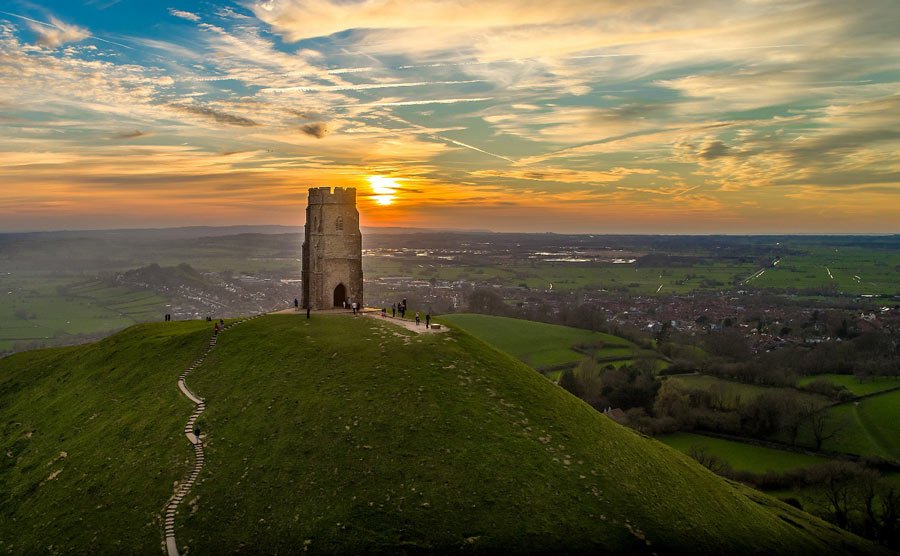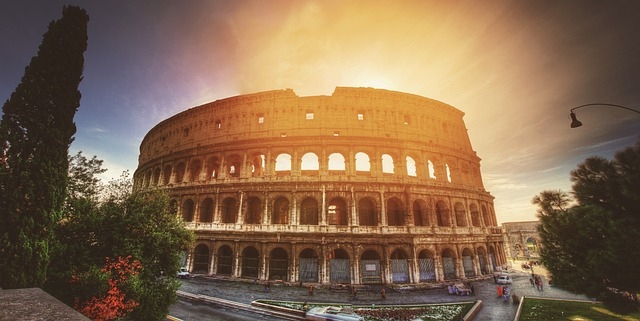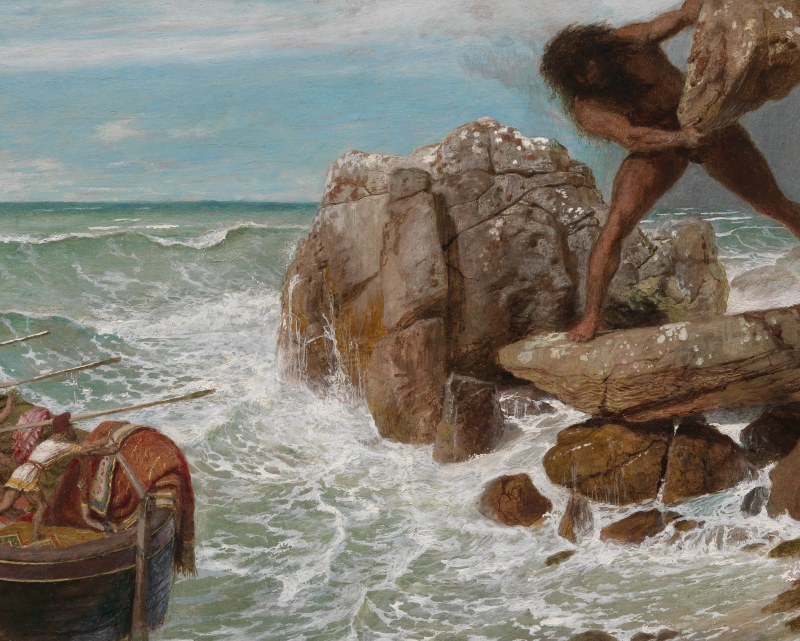
There are stories from the Middle Ages about Jesus Christ visiting parts of ancient England, which includes Penzance, Falmouth, Saint Justin-Roseland and Looe, which are all in Cornwall, as well as Glastonbury in Somerset. There are legends ascribed to King Arthur that say Jesus Christ traveled to Britain as a boy, lived at Priddy in the Mendips, and then built the first wattle cabin at Glastonbury. At Glastonbury are the ruins of the ancient Abbey that is the holy site of the First Christian Church in Europe, and these sacred grounds are the burial sites of The Virgin Mary, Joseph of Arimathea, Saint Patrick, and King Arthur.
The Abbey at Glastonbury was destroyed by a major fire in 1184, but then later rebuilt. The abbey in the 14th century became one of the most richest and powerful monasteries in England. Glastonbury abbey controlled huge tracts of the surrounding land and was involved in extreme drainage projects for proper levels of Somerset waterways. The Great and First Christian Church was destroyed by the armies of King Henry the Eight because the Catholic Pope representing the Church of Rome did not approve of the divorce that King Henry the 8th wanted from his wife, Catherine of Aragon, to marry Anne Boleyn. Charles V was Catherine’s nephew and Catherine of Aragon wanted power to be shared among her, Charles V, and King Henry 8th. Charles Fifth was Holy Roman Emperor and Archduke of Austria from 1519 to 1556, King of Spain (Castile and Aragon) from 1516 to 1556, and Lord of the Netherlands as titular Duke of Burgundy from 1506 to 1555 and the head of the increasing power of the reign of the Habsburgs.
When King Henry secretly married Anne Boleyn, he was excommunicated from the Catholic Church. King Henry and his advisors split the Catholic Church away from Rome in a procedure completed on November 3,1534. This action made him and all of his heirs, the Supreme Head of the Church of England. In 1536, King Henry ordered the closing down of the wealthy Roman Catholic abbeys, monasteries, and convents across England, Wales, and Ireland. King Henry acquired a vast amount of valuable land and property after stealing from the Roman Catholic Church and Henry made great wealth after selling these stolen Church possessions to eager buyers. Much of this ill gotten wealth was used by Henry to fund his military campaigns in the 1540’s. King Henry the 8th was a big enemy against the Roman Catholic Church of Great Britain.

Back to the legends of Christ’s voyage to ancient Great Britain. Jesus, as a 12 year old, is believed to have journeyed with Joseph of Arimathea, the man whom the Bible tells us later donated his own tomb to the tomb of Jesus Christ, after Christ’s body was taken down off the cross. Joseph of Arimathea was a wealthy Jewish merchant, a righteous man, who later became a Christian and was the Virgin Mary’s uncle and great uncle of Jesus. Joseph traveled to England on a business venture on a trading ship to buy Cornish tin and to buy silver. At the time of their arrival in England, the country was ruled by the Druids, even though Julius Caesar waged wars on Britain in 55 BC and 54 BC. Rome envied the precious metals of Britain, and decided to steal the metals and the land and rule the waterways. Not until 43AD to 84 AD, through vicious wars did Rome conquer and rule Britain. Rome ruled Britain until 409 AD. The Romans had to leave Britain because large Germanic armies were attacking the Roman heartland within the Empire and all Roman soldiers abroad had to relocate to Rome. After the Romans left Britain, the Anglo Saxons reigned over the vast territory.
There are later stories that after the Resurrection and soon afterwards the Ascension to Heaven of Jesus Christ, Joseph of Arimathea made another trip to Britain, this time bringing with the Holy Grail, which was the sacred cup used at the Last Supper of Jesus Christ and the Apostles. Joseph also carried his staff. Once in Britain, Joseph went about doing missionary work by preaching Christianity to the Britons, and then headed for Glastonbury. According to Arthurian legends, Joseph of Armithea buried the Holy Grail in a secret place , said to have been just below the Tor, at the entrance to the underworld. The tor is Glastonbury Tor: a hill near Glastonbury in the English County of Somerset, topped by the roofless Saint Michael’s Tower, A Grade I listed building. The entire historical site is managed by the National Trust, and has been designated as a scheduled monument. The water spring, known as Chalice Well, is believed to flow from there. For a long period of time, King Arthur and His Knights of the Round Table searched Britain for the Holy Grail, but never did find the Holy Grail. Centuries and centuries later, Christian crusaders searched for the Holy Grail during their wars with the Muslims in the Holy Land.
Claims that Joseph of Arimathea started the first Christian Church in Europe in Glastonbury, England are much doubted from current archeological evidence that shows the earliest Christian Church in Britain was built in 597 AD being Saint Martin’s Church. standing on a hill a mile from Canterbury The church is still in use today. Any Christian Church founded by Joseph of Arimathea simply did not survive the passage of recorded; written down time.

Christianity in Britain goes much further back before the 5th century AD. By 43 AD, Roman merchants to Britain shared Bible stories and about Jesus Christ and his disciples with the locals. Archeologists suggest that Christianity was properly introduced in Britain by 181 AD or by a later second century time period. By cica 200 AD Tertullian wrote the “Adversus Judaeos” in which he included Britain in a list of places reached by Christianity. About the same time, the Greek theologian Origen also wrote that Christianity had reached Britain. But, the time period seems much later that would have fit in with Joseph of Armithea and the Christ adolescent.
In the early Middle Ages, there was much pride, storytelling, and promotion by the monks and abbot of the Glastonbury Church and Monastery to come to the holy sites to experience antiquity history and Christian blessings. Great multitudes of pilgrims and tourists came bringing various financial offerings There is a Holy Thorn Tree seen on the grounds of the ruined Glastonbury Church that is believed to miraculously sprang up after the staff of Joseph of Armitheas plunged into the ground. The Holy Thorn Tree buds or flowers around Easter and again at Christmas. The tradition of sending a flowered branch of a Glastonbury thorn tree seems to have begun in the early 1600’s. when a branch was sent to Queen Anne, King James I’s consort. A spray is still cut from the thorn tree in Saint John’s Church yard and then sent to the sovereign every Christmas by the Vicar and the Mayor of Glastonbury.
Famous British poet, painter, and printmaker, William Blake (born November 28, 1757; died August 12, 1827) wrote a poem about Jesus Christ visiting ancient Britain; the poem is called “Jerusalem”. One part of the moving poem reads: “And did those feet in ancient time, Walk upon England’s mountains green, And was the holy Lamb of God, On England’s pleasant pastures seen!” William Blake published his literary classical “Jerusalem: in 1804.


